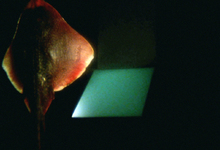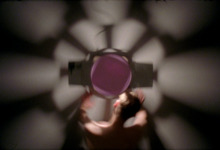- Images (9)
- Links (1)
- Agenda

|

|

|

|

|

|

|

|

|
As part of its 24th edition, FestCurtasBH (Festival Internacional de Curtas de Belo Horizonte, Brazil) invites Light Cone to present a carte blanche with films from its collection. This program, on the theme of dreams, has been conceived by Emmanuel Lefrant and consists of two screenings that will take place on Saturday 15 and Sunday 16 October 2022.
Soft Dreams
In his sleep, the dreamer disturbs reality and wishes to transform it, as Freud theorizes in The Interpretation of Dreams (1909). However, just like hallucination, the dream does not seem to have a recipient. Both take place in a narrative only in the aftermath of their production. From daydreaming to trance, passing through near-death experiences, drunkenness, orgasm or meditative states, these "modified states of consciousness" bring out another world, little explored but of great richness. Modern psychiatry and psychoanalysis have associated dreaming, madness and mystical trance with the phenomena of hysteria. However, if we are to refuse such reduction, we can admit that we are entering a "different" world. Indigenous societies have well grasped this "otherness" and this strangeness, by establishing a system of communication between this world down here and the supernatural one, in which the dreamer, the madman and the person in a trance are privileged intermediaries. Our modern societies have broken these relationships, and the supernatural is thus rejected everywhere for the sake of a scientific reason. Nevertheless, dreams, madness and trance continue to question us and make it possible to reestablish communication between two worlds, that of the conscious and the unconscious, which cinema—and in particular experimental cinema—has not failed to interrogate.
The dream is not, however, a specifically human phenomenon. Animals also dream, and the content of these dreams, which cannot be told, is even more mysterious. This is what the crow embodied in Peter Conrad Beyer's film, Le Rêve (2020), reveals to us. The bird, in an animal trance, merges with nature and becomes nature itself, which sends us back its own image and its end-of-the-world anxieties.
The ray, this strange animal from the abyss, is no more reassuring in the film by Portuguese duo João Maria Gusmão and Pedro Paiva. In Dream of the Ray Fish (2011), the filmmakers stage in one of their "poetic-philosophical fictions" a ray whose image is returned by a rotating mirror, in a gesture that illustrates their interest in the paranormal, the inexplicable and the unconscious. By slowing down the speed of the images or playing with overlays, their films transform micro-events into hypnotic and mesmerizing events, creating extraordinary worlds that open new windows to our daily observations. Their works are part of their research on "Abissology", a term coined by French author René Daumal, which describes the science of the abyss, revisited in this program by the filmmakers Christopher Becks and Emmanuel Lefrant in I Don’t Think I Can See an Island (2016). In this film, the filmmakers deliver a free adaptation of Mont Analogue (1952), a novel that has inspired several generations of artists and musicians, from Europe to the United States. Displaying pataphysical features, the novel is a spiritual quest in which the mountain becomes the place where it is possible to communicate with the afterlife. This mountain balances the mountainous masses of the Northern Hemisphere and seems to correspond to all the mountains evoked by ancient traditions and religions: Sinai, Meru, Olympus etc. At its base, they discover a cosmopolitan society entirely focused on climbing and dominated by high mountain guides. They also decide to undertake the escalation. The novel abandons them on their way to the ineffable, in the middle of a sentence in the fifth chapter.
An afterlife that we find through the practices—ancestral but also modern—associated with trance. In Ben Russell's film Black and White Trypps Number Three (2007), we observe a group of young dancers, enlighten by a spotlight pointed at them during a concert by the noise-rock group from Rhode Island, Lightning Bolt. The film "documents the transformation of an audience's collective ecstasy into a trance rite of the highest spiritual level, (...) a dance that transforms into a form of secular ecstasy" (Michael Sicinski). This is the case in Candomblé No Togo - Mãe de Santo Djatassi (1972), by one of the initiators of Tropicalism, José Agrippino de Paula, in which the Brazilian filmmaker goes back to the roots of Candomblé practiced in Brazil, filming ceremonies in Togo and in Dahomey (present-day Benin). In the 1950s, Maya Deren (to be found later in this program) was already interested in voodoo, the Haitian version of these African trance rituals.
Closing this first program, two works that arrange systems operating the creation of dreams and their reproduction. Dream Work (2001), by Peter Tscherkassky, lasts the duration of a deep-sleep phase and reconstructs an explicitly erotic dream, very marked here by the "male gaze" (described by Laura Mulvey in her essay "Visual Pleasure and Narrative Cinema" [1975]) of the Austrian filmmaker. The film's images, as Bert Rebhandl describes it, "swirl around each other in a maelstrom where the classical psychoanalytic theory of the unconscious functioning of the conscious gradually fades away, in order to make room to a supreme logic of neuronal chaos, before reconstituting itself into a meta-dream that could be described, paraphrasing Freud, as the 'representation of the image'”. Finally, with the British filmmaker Stanley Schtinter's Dreamachine (2018), we revisit Brion Gysin's eponymous work (1960), known as the first work in history to be 'viewed' with eyes closed, an approach reminiscent of the theory of closed-eye vision, developed some years later by Stan Brakhage in his book Metaphors on Vision (1963). The Dreamachine is a rotating cylinder with slots and a bulb in its center. While the cylinder is rotating, the light emitted by the bulb passes through the slits at a particular frequency, which provides visions to the spectator, when he closes his eyes. Light impulses stimulate the optic nerve and change the frequency of the electrical impulses in the brain. The spectator, in what can be a very intense experience, sees the appearance of complex color patterns, with increasing brightness, as well as swirling shapes. An invitation to end the session with closed eyelids, concentrating only on the pulsations emitted by the screen...
How not to include in a program of experimental films about dreams the essential Meshes of the Afternoon (1943) by the iconic American filmmaker Maya Deren? In the film, which seems to be directly inspired by Jean Cocteau's Sang d'un Poète (Blood of a Poet) (1930) (although Maya Deren has repeatedly claimed to have never seen the film), a young woman arrives home and falls asleep. In her dream, she sees herself returning home, tortured by loneliness and frustration, and impulsively commits suicide. The story changes when imaginary and dream apparently merge with the real. Maya Deren explained that her film focuses on "the inner experiences of an individual. It does not record an event that other people might witness. Rather, it replicates how an individual's subconscious will develop, interpret and elaborate an apparently simple and casual incident into a critical emotional experience."
"Breathe in, breathe out". Soft Fiction (1979) by Chick Strand begins with these words, as if to invite the viewer to be lulled into the ecstatic state of dreaming. Yet, the film does not tell dreams as such, but narratives, memories or traumas which seem to be similar, in their form, to the dream paradigm. The figure of Maya Deren haunts this work, via the presence of Amy Halpern in the few sequences that punctuate the film and separate the narratives from each other, scenes that explicitly refer to Meshes of the Afternoon. When Chick Strand makes Soft Fiction, the United States are going through the second wave of the feminist movement. The film shakes up, because of the harshness of the stories narrated, even though the female perspective dominates the whole film. It gives five women the necessary space to, in Chick Strand's words, perform "the exorcism of an experience". The filmmaker, however, has always refused the label of a feminist, insisting that she was not interested in politics but rather in her own intuitive connections and her passionate relationships with people. The film, which mixes eroticism, intimacy and visual poetry, bathed in a deeply dreamlike atmosphere, is a joyful hymn to life and to women.
– Emmanuel Lefrant, translated by Nanda Rossi

|
LE RÊVE
by Peter-Conrad BEYER 2020 / DCP / color-b&w / sound / 8' 21 |

|
GETTING INTO BED + DREAM OF A RAY FISH + WAVE + WHEELS + THE HORSE OF THE PROPHET
by João Maria GUSMAO & Pedro PAIVA 2011 / 16mm / color / silent / 12' 52 |

|
I DON'T THINK I CAN SEE AN ISLAND
by Christopher BECKS & Emmanuel LEFRANT 2016 / 35mm / color / sound / 4' 10 |

|
BLACK AND WHITE TRYPPS NUMBER THREE
by Ben RUSSELL 2007 / 35mm / color / sound / 11' 30 |

|
CANDOMBLÉ NO TOGO - MÃE DE SANTO DJATASSI
by José AGRIPPINO DE PAULA 1972 / DCP / color / sound / 20' 00 |

|
DREAM WORK
by Peter TSCHERKASSKY 2001 / 35mm / b&w / sound / 11' 00 |

|
DREAMACHINE
by Stanley SCHTINTER 2018 / 35mm / color / sound / 4' 33 |

|
MESHES OF THE AFTERNOON
by Maya DEREN & Alexander HAMMID 1943 / 16mm / b&w / sound / 14' 00 |

|
SOFT FICTION
by Chick STRAND 1979 / 16mm / b&w / sound / 56' 00 |
| address |
FestCurtasBH - Belo Horizonte International Short Film Festival Cine Humberto Mauro (Palácio das Artes/FCS) – Av. Afonso Pena, 1537 30120-010 Belo Horizonte, M.G. Brésil |
|---|---|
| related link |
FestCurtasBH
|